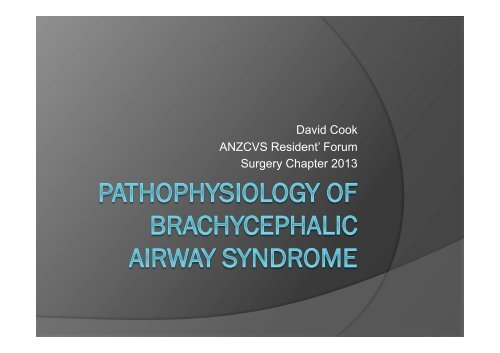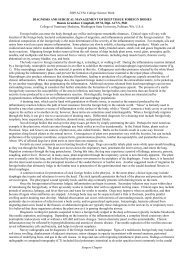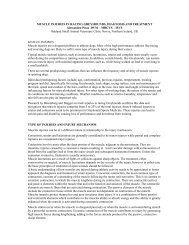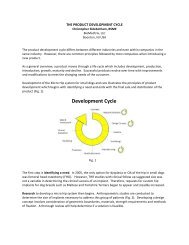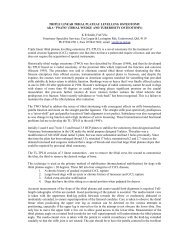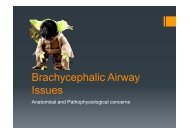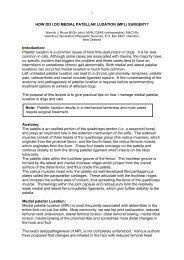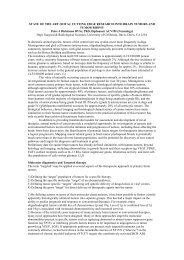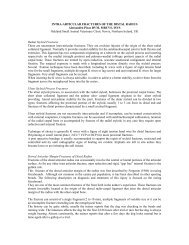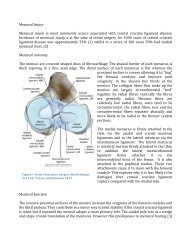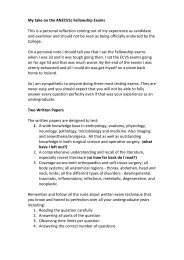Pathophysiology of Brachycephalic Airway Syndrome
Pathophysiology of Brachycephalic Airway Syndrome
Pathophysiology of Brachycephalic Airway Syndrome
Create successful ePaper yourself
Turn your PDF publications into a flip-book with our unique Google optimized e-Paper software.
David Cook<br />
ANZCVS Resident’ Forum<br />
Surgery Chapter 2013
PRIMARY ABNORMALITIES 1<br />
Shortened maxilla –<br />
bony structures<br />
reduced in length<br />
without relative<br />
reduction in s<strong>of</strong>t<br />
tissue length<br />
Linked to multiple<br />
single nucleotide<br />
polymorphisms in<br />
the Cfa1 gene<br />
Bannasch 2010
PRIMARY ABNORMALITIES 2<br />
Stenotic Nares<br />
Elongated S<strong>of</strong>t Palate<br />
Thickened as well as elongated<br />
Caudally displaced nasopharyngeal<br />
turbinates<br />
Redundant pharyngeal mucosal tissue<br />
Hypoplastic trachea
ABNORMALITIES OF GAS FLOW 1<br />
Anatomic abnormalities lead to increased<br />
upper airway resistance compared to meso<br />
and dolicocephalic animals<br />
Turbulent flow <strong>of</strong> gas is more likely<br />
Dogs and cats prefer to breathe through<br />
the nose<br />
Resistance is reduced with mouth<br />
breathing but there is loss <strong>of</strong> nasal function<br />
(humidification, filtration <strong>of</strong> particulate<br />
material, reduced olfactory function)
ABNORMALITIES OF GAS FLOW 2<br />
Increased resistance and turbulent flow<br />
(rather than laminar flow) increase the<br />
amount <strong>of</strong> driving pressure required to<br />
move gas<br />
Increased driving pressure requires<br />
increased work by respiratory muscles
ABNORMALITIES OF GAS FLOW 3<br />
Respiratory disease is <strong>of</strong>ten associated with<br />
reduced airway diameter<br />
Upper airway obstruction<br />
Dynamic lower airway disease<br />
Fluid or exudate accumulation<br />
These changes lead to<br />
○ Increased resistance to flow<br />
○ Increase in driving pressure necessary to generate the<br />
breath<br />
○ Increased likelihood <strong>of</strong> turbulent flow<br />
○ Increased work <strong>of</strong> breathing<br />
Exaggerated breathing efforts can also lead to high<br />
gas flows which increase the likelihood <strong>of</strong> turbulent<br />
flow and work <strong>of</strong> breathing
LAMINAR GAS FLOW EQUATION<br />
Increased resistance to airflow is caused by a<br />
decrease in airway radius described by<br />
Poiseulle’s Law – Q = πΔPr 4 /8ηl<br />
Q = flow rate<br />
ΔP = pressure difference between the ends <strong>of</strong> the<br />
airway<br />
r = radius <strong>of</strong> airway<br />
η = viscosity <strong>of</strong> gas (eta)<br />
l = length <strong>of</strong> airway<br />
Resistance to laminar flow is directly related to<br />
the length <strong>of</strong> the tube and the viscosity <strong>of</strong> the<br />
fluid, and is inversely related to the radius <strong>of</strong> the<br />
tube 4
TURBULENT GAS FLOW<br />
Mathematical equations not easily used<br />
Turbulent flow occurs when there is a<br />
disruption <strong>of</strong> orderly laminar flow à occurs at<br />
airway bifurcations and branches and with<br />
partial airway obstructions (abrupt changes in<br />
airway diameter) as well as at high flow rates<br />
Turbulent flow can return to laminar if there is<br />
long enough distance<br />
Resistance to turbulent flow is directly related<br />
to the density <strong>of</strong> the fluid and is inversely<br />
related to the tube radius 5<br />
This is a non linear relationship
REYNOLDS NUMBER<br />
Predicts laminar or turbulent flow<br />
Laminar flow 4000
ENERGY REQUIRED FOR<br />
BREATHING<br />
Change in pressure required<br />
Laminar flow<br />
ΔP ≈ Q x R<br />
Turbulent flow<br />
ΔP ≈ Q 2 X R<br />
Where ΔP represents the required effort <strong>of</strong><br />
breathing and is close to the difference<br />
between atmospheric pressure and<br />
intrapleural pressure (= transpulmonary<br />
pressure)
AIRWAY RESISTANCE IN NORMAL<br />
DOGS<br />
Inspiration<br />
79% nasal<br />
6% laryngeal<br />
15% small airway<br />
Expiration<br />
74% nasal<br />
3% laryngeal<br />
23% small airway
UPPER AIRWAY RESISTANCE IN<br />
BAS DOGS<br />
Experimentally, clinically affected<br />
bulldogs have 6 x the upper airway<br />
resistance <strong>of</strong> laboratory beagles, and 5 x<br />
the upper airway resistance <strong>of</strong> mildly/<br />
non clinically affected bulldogs<br />
Weistner AJVR 2007
CHRONIC CHANGES TO AIRWAY<br />
RESISTANCE (4 m experimental)<br />
The image cannot be displayed. Your computer may not have enough memory to open the image, or the image may have been corrupted. Restart your computer, and then open the file again. If the red x still appears, you may have to delete the image and then insert it again.<br />
Partial bilateral obstruction leads to large<br />
increase in airway resistance<br />
Also leads to large decrease in intrapleural<br />
pressure reflecting increased inspiratory effort<br />
Ohnishi Laryngoscope 1971 (81:712)
WORK OF BREATHING<br />
Energy is required to overcome frictional<br />
resistance to gas flow through airways, and<br />
elastic recoil <strong>of</strong> lungs/chest wall<br />
Normal lung under resting respiratory effort –<br />
all work is done by inspiratory muscles à<br />
exhalation achieved through potential<br />
energy stored in expanded elastic tissues <strong>of</strong><br />
lung and chest wall<br />
Resp muscle oxygen consumption is less<br />
than 2% <strong>of</strong> the total metabolic rate<br />
<strong>Airway</strong> narrowing increases he work <strong>of</strong><br />
breathing necessary to overcome airway<br />
resistance
RESPIRATORY STRATEGY OF BAS<br />
DOGS 1<br />
Prolonged inspiratory phase with<br />
increased flow rate<br />
Markedly increased expiratory flow rate<br />
reflecting increased muscle effort<br />
Reduced or absent respiratory pause<br />
Increased respiratory rate<br />
Change in measured respiratory<br />
parameters reflects fixed and dynamic<br />
components <strong>of</strong> upper resp obstruction
RESPIRATORY STRATEGY OF BAS<br />
DOGS 2<br />
BAS dogs without clinical signs display<br />
respiratory patterns similar to normal<br />
dogs with experimental upper resp<br />
obstruction<br />
Similar changes demonstrated with<br />
Plethysmography - Bernaerts 2010 Vet J<br />
Tidal Flow Volume Loops – Amis 1986 AJVR
WHAT IS PLETHYSMOGRAPHY<br />
Pressure measured in box to<br />
calculate changes in volume<br />
over time<br />
RR<br />
Est tidal volume/kg (TV/BW)<br />
Est minute vol/kg (MV/BW)<br />
Inspiratory and expiratory times<br />
(Ti, Te)<br />
Relaxations time (= time at<br />
which 65% <strong>of</strong> tidal vol exhaled)<br />
(RT)<br />
Peak inspiratory and expiratory<br />
pseud<strong>of</strong>lows per KG (PIF or<br />
PEF/BW)<br />
Enhanced pause (unitless index<br />
<strong>of</strong> airflow limitation or<br />
bronchoconstriction) à<br />
calculated by Penh = (PEF/PIF)<br />
x ((Te – RT)/RT)<br />
H<strong>of</strong>fman 2007
ABNORMALITIES DESCRIBED BY<br />
PLETHYSMOGRAPHY<br />
Te/Ti, PIF/BW, and RT are significantly<br />
lower / prolonged) compared to normal dogs<br />
PEF/BW, PEF/PIF, Penh and Pause were<br />
significantly higher / prolonged compared to<br />
normal dogs<br />
1 day post operative changes<br />
○ Only significant change was decrease in PEF/PIF<br />
value<br />
○ Compared to normal dogs, PEF/PIF, Penh and<br />
pause remained significantly increased in<br />
brachycephalic dogs however Te/Ti, RT, PIF/BW<br />
and PEF/BW were not statistically significantly<br />
different
Bernaerts 2010 Vet J
ARTERIAL BLOOD GAS<br />
ABNORMALITIES 1<br />
Significantly lower PaO 2 (86 vs 100)<br />
Significantly higher<br />
PaCO 2 (36 vs 32)<br />
PCV (48 vs 44)<br />
Arterial blood pressure (oscillometric mean<br />
123, systolic 178 and diastolic 95)<br />
Horeau JVIM 2012
BLOOG GAS ABNORMALITIES 2<br />
Most abnormalities should be compensated for by<br />
peripheral chemoreflex via central control <strong>of</strong> respiratory<br />
patterns in normal animals<br />
In particular CO 2 diffusion is unlikely to be limited at<br />
high respiratory rates as long as alveolar ventilation is<br />
adequate<br />
Peripheral chemoreflex also stimulates sympathetic<br />
drive – increase blood pressure in response to<br />
hypoxaemia and hypercapnia<br />
Habituation – change to set points<br />
Humans with sleep apnoea are predisposed to<br />
hypertension via activation <strong>of</strong> RAAS and the<br />
sympathetic nervous system. Changes are linked to<br />
obesity<br />
PCV increase may be compensatory for chronic<br />
hypoxia or reflect RAAS activation
BLOOD GAS ABNORMALITIES 3<br />
Slawuta 2011<br />
PaO 2 = 73<br />
PaCO 2 = 52<br />
More extreme changes relative to<br />
Horeau’s study<br />
Population <strong>of</strong> French Bulldogs<br />
Significant improvement in values<br />
following alarplasty (PaO2 = 82, PaCO 2<br />
= 49)
CYTOKINE ABNORMALITIES 1<br />
Rancan 2013<br />
Measured pro and anti inflammatory<br />
cytokines in normal and BAS dogs (with<br />
and without clinical signs)<br />
All BAS dogs had elevated TNF α<br />
IL – 17A increased in markedly affected<br />
BAS dogs – in humans thought to<br />
contribute to subeptihelial fibrosis and<br />
airway remodelling in asthma
CYTOKINE ABNORMALITIES 2<br />
NO increased in severely affected dogs,<br />
trend to increase in other BAS dogs<br />
IL-10 (anti inflammatory cytokine) –<br />
significantly higher in BAS dogs – in<br />
humans used as marker <strong>of</strong> pulmonary<br />
disease therapy in COPD
ACUTE PHASE PROTEINS 1<br />
Planellas 2012<br />
C reactive protein, haptoglobin, cardiac<br />
troponin I levels measured in 50 BAS<br />
dogs<br />
Link between sleep apnoea in people<br />
and increased rate <strong>of</strong> CV complications<br />
Patients had concurrent ECG
ACUTE PHASE PROTEINS 2<br />
47% <strong>of</strong> dogs had increased CTn I (100%<br />
english bulldogs, 55% French Bulldogs)<br />
14% CRP, 22% Hb<br />
Dogs with everted laryngeal saccules had<br />
increased resp scores and sig increase in CRP<br />
Correlation between severity <strong>of</strong> GI signs and<br />
CTnI levels<br />
CTnI sensitive marker <strong>of</strong> acute myocardial<br />
injury but is non specific – can increase (in<br />
humans) with tachycardia and inadequate<br />
oxygen supply, pulmonary hypertension,<br />
systemic hypertension, acute exacerbations <strong>of</strong><br />
COPD, strenuous endurance exercise
CONCURRENT CARDIAC DISEASE<br />
Affected breeds pre disposed to heart<br />
disease<br />
CKCS – acquired valvular disease<br />
Bulldogs – Pulmonic stenosis<br />
Theory (Monnet in Slatter, 2003) <strong>of</strong><br />
pulmonary hypertension secondary to<br />
reflex pulmonary perfusion changes<br />
under chronic hypoxic conditions<br />
eventually leading to cor pulmonale and<br />
right sided heart failure
STENOTIC NARES 1<br />
Axial deviation <strong>of</strong> the dorso lateral nasal<br />
cartilage and associated mucosa and<br />
epithelium<br />
Leads to upper respiratory obstruction in<br />
affected breeds<br />
Theorised to lead to secondary changes<br />
Can be treated at a young age (Pink<br />
2006)
STENOTIC NARES
STENOTIC NARES 2<br />
Wiestner 2007<br />
<strong>Brachycephalic</strong> dogs showing clinical<br />
signs <strong>of</strong> upper resp obstruction have 6x<br />
the resistance <strong>of</strong> laboratory beagles<br />
BAS dogs not showing CSx have 2x the<br />
resistance <strong>of</strong> lab beagles<br />
Slawuta 2011 showed significant<br />
improvement in PaO 2 following surgical<br />
correction
SOFT PALATE<br />
S<strong>of</strong>t palate arises from the caudal<br />
margin <strong>of</strong> the hard palate and extends<br />
aborally<br />
Considered elongated if the tip <strong>of</strong> the<br />
s<strong>of</strong>t palate extends more than 1-3mm<br />
distal to the most rostral aspect <strong>of</strong> the<br />
epiglottis
ELONGATED SOFT PALATE
SOFT PALATE PHYSIOLOGY<br />
Sensory component as part <strong>of</strong> swallowing<br />
reflex (CN V)<br />
Closure <strong>of</strong> intrapharyngeal region to<br />
prevent nasopharyngeal reflux<br />
Levator palatini and palatopharyngeus mm<br />
elevate palate and draw caudal palate,<br />
palatopharyngeal arches and caudal<br />
pharynx together to close nasopharynx<br />
Elongated palate causes stertor and stridor<br />
which are audible vibrational effects
SOFT PALATE CHANGES 1<br />
Pichetto 2011 found that <strong>Brachycephalic</strong><br />
dogs with few or no clinical signs had<br />
histological abnormalities <strong>of</strong> the palate<br />
Epithelial hyperplasia (worse on oral side)<br />
Oedema (lamina propria, worse aborally)<br />
Fibrosis, abnormal collagen fibre orientation<br />
Mucous gland hyperplasia and increased mucin<br />
production<br />
Muscular portion did not extend to aboral tip<br />
Changes to muscle fibres consistent with<br />
chronic trauma
SOFT PALATE CHANGES 2<br />
Grand 2011 found<br />
that s<strong>of</strong>t palate<br />
thickness increased<br />
with severity <strong>of</strong><br />
clinical signs based<br />
on a CT<br />
measurement and<br />
clinical score
NASOPHARYNGEAL TURBINATES<br />
Caudally displaced nasopharyngeal<br />
turbinates identified by endoscopy or CT<br />
Varying degrees reported<br />
Ginn 2011 20% <strong>of</strong> dogs with BAS (11/52)<br />
○ 82% <strong>of</strong> these were pugs<br />
Bernaerts 2010 – 1 English bulldog (1/11)<br />
Grand 2011 – none reported<br />
Oechtering 2007 – abstract ‘up to 100%’ – CT<br />
study described rostral and caudal abnormalities<br />
with ‘crude and abnormal branching <strong>of</strong> lamellae’
Ginn 2008
HYPOPLASTIC TRACHEA 1<br />
Congenital abnormality in which the ends<br />
<strong>of</strong> the tracheal cartilage rings overlap<br />
Lumen is rigid and narrow with reduced or<br />
absent dorsal tracheal membrane<br />
Theoretically may complicate BAS due to<br />
increased resistance to flow (laminar flow is<br />
proportional to radius 4 )<br />
Multiple studies have found no worsening<br />
<strong>of</strong> prognosis with surgery when hypoplastic<br />
trachea is present (Riecks 2007, Lorison<br />
1997, Coyne 1992))
Clarke 2011
HYPOPLASTIC TRACHEA 2<br />
Ratio for measurement <strong>of</strong> tracheal diameter<br />
radiographically is a ratio between the<br />
diameter <strong>of</strong> the tracheal lumen and the<br />
distance between the mid body <strong>of</strong> the first<br />
thoracic verterbae and the middle <strong>of</strong> the<br />
manubrium <strong>of</strong> the sternum<br />
Normal ranges<br />
Normal dogs > 20%<br />
<strong>Brachycephalic</strong> dogs > 16%<br />
Bulldogs 12.7%
HYPOPLASTIC TRACHEA 3<br />
Pink 2006 reported histological changes<br />
from the trachea <strong>of</strong> 1 bulldog post<br />
mortem<br />
Loss <strong>of</strong> ciliated epithelium<br />
Mucosal hypertrophy<br />
Mucous gland necrosis<br />
Marked mononuclear infiltrate<br />
Submucosal fibrosis
HYPOPLASTIC TRACHEA 4<br />
Improvement in tracheal diameter ratio<br />
has been documented in group <strong>of</strong> 6<br />
bulldogs admitted for<br />
bronchopneumonia (Clarke 2011)<br />
Bulldogs puppies improved from 0.07 to<br />
0.14 (significant)<br />
Non brachycephalic control puppies with<br />
bronchopneumonia improved from 0.14<br />
to 0.17 (no significant)
HYPOPLASTIC TRACHEA 5<br />
Infectious agents cultured from these<br />
puppies were mixed<br />
5 cases supported aspiration pneumonia<br />
3 cases had bordetella sp
SECONDARY CHANGES<br />
Acquired pharyngeal muscular dysfunction<br />
Everted Tonsils<br />
Everted laryngeal saccules<br />
Laryngeal collapse<br />
Dynamic lower airway disease<br />
Structural and inflammatory gastrointestinal<br />
changes<br />
Aspiration pneumonia/pulmonary oedema<br />
(complications)
PHARYNGEAL CHANGES 1<br />
In humans, palatine muscles contract to<br />
stiffen upper airways in response to<br />
increasingly negative upper airway<br />
pressures and hypoxic hypercapnia à<br />
palatine contraction helps to partition<br />
airflow
PHARYNGEAL CHANGES 2<br />
Bulldogs studied in a human sleep<br />
apnoea model were found to have<br />
fibrosis <strong>of</strong> pharyngeal dilator muscles,<br />
abnormal muscle fibre morphology and<br />
increased proportions <strong>of</strong> Type II fibres<br />
MRI studies found that pharyngeal<br />
muscles relax then undergo<br />
spontaneous vigorous contraction when<br />
the patient becomes hypoxic
PHARYNGEAL CHANGES 3<br />
Rat models suggest increased fatigue<br />
ability <strong>of</strong> pharyngeal muscles under<br />
hypoxic conditions<br />
<strong>Brachycephalic</strong> dogs are likely to have<br />
reduced ability to moderate pharyngeal<br />
tone when they are fatigued particularly<br />
a reduced ability to dilate the pharynx<br />
during inspiration<br />
This is likely to increase resistance and<br />
increase the risk <strong>of</strong> turbulent flow
EVERTED TONSILS<br />
Described in up to 56% <strong>of</strong> cases (Fasanella<br />
2010)<br />
Lymphoid hyperplasia – mild/moderate<br />
Infiltrate <strong>of</strong> neutrophils or eosinophils<br />
common<br />
Stimulated by turbulent airflow, increased<br />
negative pressure <strong>of</strong> inspiration and<br />
antigenic stimulation related to<br />
regurgitation<br />
Contribute to narrowing <strong>of</strong> airway and risk<br />
<strong>of</strong> turbulent flow when panting
LARYNGEAL SACCULES 1<br />
Saccule = mucosal lining <strong>of</strong> lateral laryngeal ventricle<br />
(between vestibular and vocal folds) à place with<br />
least structural resilience in laryngeal wall<br />
Historical first stage <strong>of</strong> Laryngeal collapse (Leonard<br />
1960)<br />
Considered separate condition to laryngeal collapse<br />
by Torrez and Hunt 2006<br />
Hypothesis is that saccules evert in response to<br />
chronic negative airway pressure<br />
Reported incidence mostly in the range <strong>of</strong> 55-65% in<br />
larger case series (Poncet, Torrez, Riecks,<br />
Fasanella)
LARYNGEAL SACCULES 2<br />
Cantatore 2012 reported histologic findings<br />
and endoscopic follow up following<br />
staphylectomy, alarplasty and resection <strong>of</strong><br />
1 ventricle<br />
Histological findings<br />
Oedema<br />
Epithelial hyperplasia/keratosis<br />
Fibrosis<br />
Lymphatic dilation<br />
Inconsistent inflammatory cell population –<br />
where present lymphoplasmacytic/mast cells
Cantatore 2012
LARYNGEAL SACCULES 3<br />
Surgical treatment <strong>of</strong> other BAS<br />
abnormalities did not lead to<br />
improvement in histologic characteristics<br />
<strong>of</strong> saccules resected 2-4 months later<br />
Photographs in paper give impression <strong>of</strong><br />
increased size <strong>of</strong> saccules left in situ<br />
Patients showed improved clinical<br />
scores
LARYNGEAL COLLAPSE<br />
Stages <strong>of</strong> collapse described by Leonard –<br />
1 to 3 (saccules, cuneiform, corniculate)<br />
Progressive loss <strong>of</strong> structural integrity <strong>of</strong><br />
cartilage leads to collapse and further<br />
contribution to airway obstruction<br />
Excluding stage 1 collapse most studies<br />
report 53-67% range<br />
Riecks 2007 reported 8.1%<br />
Pink 2006 reported laryngeal collapse from<br />
4.5m age
Stage 2 collapse – Tobias and<br />
Johnston Ch101
LARYNGEAL COLLAPSE 2<br />
Pink described histologic changes from<br />
1 Bulldog post mortem (arytenoid)<br />
Loss <strong>of</strong> normal ciliated epithelium<br />
Muscosal hypertrophy<br />
Abnormal mucosal glands show marked<br />
necrosis with marked mononuclear infiltrate<br />
Submucosal fibrosis
Pink 2006
LARYNGEAL COLLAPSE 3<br />
Collapse <strong>of</strong> the arytenoid cartilages can<br />
occur without eversion <strong>of</strong> laryngeal<br />
saccules - unclear whether this is a<br />
manifestation <strong>of</strong> BAS or a separate<br />
condition with congenital axial<br />
displacement <strong>of</strong> cuneiform processes<br />
(Torrez 2006, Nelissen 2012)<br />
Laryngeal paralysis may also be a feature<br />
4/6 dogs in this study had a history <strong>of</strong><br />
respiratory surgery and many were<br />
brachycephalic breeds (Nelissen 2012)
LARYNGEAL COLLAPSE 4<br />
Presence <strong>of</strong> laryngeal collapse significantly<br />
increases the risk <strong>of</strong> post operative dyspnoea<br />
in some studies (White 2012)<br />
9/10 dogs with stage 3 collapse experienced<br />
post operative dyspnoea<br />
20% <strong>of</strong> stage 2 collapse<br />
Post operative dyspnoea in most larger BAS<br />
studies is in the range <strong>of</strong> 5-8% despite<br />
reported rates <strong>of</strong> laryngeal collapse <strong>of</strong> 55-65%<br />
Laryngeal collapse linked to multiple upper<br />
airway abnormalities (not identified in patients<br />
with elongated palate only e.g. CKCS Torrez<br />
2006)
DYNAMIC LOWER AIRWAY<br />
DISEASE 1<br />
Collapse <strong>of</strong> the left mainstem bronchus<br />
and particularly the left cranial bronchus<br />
documented in 70 – 87.5% <strong>of</strong> patients<br />
De Lorenzi 2009 35/40 BAS patients<br />
had abnormalities<br />
Of these, 84% were left sided<br />
<strong>Airway</strong>s distal to the mainstem bronchi<br />
were typically normal<br />
Bernaerts 2010 reported 70%
De Lorenzi 2009
DYNAMIC LOWER AIRWAY<br />
DISEASE 2<br />
Proposed a grading scheme for lower<br />
airway collapse<br />
Grade 1 – up to 30% reduction in diameter<br />
Grade 2 – 30-60%<br />
Grade 3 - >60%<br />
Each bronchus assigned individual score<br />
Laryngeal collapse correlated with more<br />
severe bronchial collapse<br />
Severity <strong>of</strong> collapse did not correlate with<br />
surgical outcome (telephone follow up)
DYNAMIC LOWER AIRWAY<br />
DISEASE 3<br />
Increased upper airway resistance for<br />
both inspiration and expiration leads to<br />
recruitment <strong>of</strong> muscles<br />
Increases transpulmonary pressure<br />
under forced exhalation<br />
Increase pressure on structural support<br />
(cartilage) leads to weakening and<br />
collapse<br />
Juvenile cartilage more prone to<br />
deformation under stress
DYNAMIC LOWER AIRWAY<br />
DISEASE 4<br />
Increased expiratory pressure gradient increases<br />
gas velocity<br />
Increased velocity leads to reduction in intraluminal<br />
pressure (Bernoulli effect)<br />
This leads to greater transpulmonary pressure<br />
gradient and increased propensity to collapse<br />
Collapse <strong>of</strong> airways causes disparity in lumen<br />
diameter which increases the risk <strong>of</strong> turbulent flow<br />
In people, left mainstem bronchus is more prone to<br />
collapse – thought to relate to increased length<br />
relative to right<br />
Collapsing left cranial bronchus may be linked to<br />
increased rates <strong>of</strong> lung lobe torsion in<br />
brachycephalic dogs in that lobe (pugs)
GASTRO INTESTINAL 1<br />
Poncet 2005 (and 2006) describe<br />
findings and long term outcomes <strong>of</strong><br />
treatment (surgical and medical)<br />
Investigated the link between<br />
gastrointestinal pathology and severity<br />
<strong>of</strong> upper respiratory symptoms
Poncet 2005
GASTRO INTESTINAL 2<br />
Respiratory and gastrointestinal grading<br />
systems – 1 (mild) – 3 (severe)<br />
Population <strong>of</strong> mostly French and English<br />
Bulldogs<br />
Routine upper GI endoscopy (all) and<br />
biopsy (most) <strong>of</strong> gastric and duodenal<br />
mucosa<br />
Assessed mucosal pathology as mild,<br />
moderate or severe
GASTROINTESTINAL 3<br />
Oesophageal changes – 60% overall<br />
Tortuous/non linear oesophagus – 16%<br />
Gastroesophageal reflux like mucosal<br />
changes – 31%<br />
Atony <strong>of</strong> lower oesophageal sphincter – 38%
GASTROINTESTINAL 4<br />
Stomach – 97.3%<br />
Mild – severe inflammatory changes (24%<br />
severe) – chronic, diffuse, follicular gastritis<br />
86% pyloric mucosal hyperplasia<br />
Hiatal hernia 4%
GASTROINTESTINAL 5<br />
Duodenum<br />
Unable to evaluate duodenum in 7 cases<br />
(9.6%) due to inability to pass scope through<br />
pylorus (small, hyperplastic)<br />
Of the remaining 66, 53% had duodenal<br />
inflammation
Poncet 2005
GASTROINTESTINAL 6<br />
2 dogs had no GI clinical signs, but still<br />
had inflammatory changes<br />
Significant relationship between severity<br />
<strong>of</strong> clinical signs (respiratory and GI) for<br />
French Bulldogs, males and heavy dogs<br />
(>13.8kg)<br />
Severe GI signs significantly associated<br />
with high body weight and English<br />
Bulldog breed
GASTROINTESTINAL 7<br />
10 (19.6%) <strong>of</strong> the cases from the first study<br />
had follow up endoscopic exam following<br />
surgical therapy and medical therapy<br />
(omeprazole, cisapride, +/- sucralfate and<br />
prednisolone)<br />
7/10 had no Clinical signs<br />
3/10 were not completely improved<br />
All had a clear improvement in severity<br />
inflammatory changes<br />
Anatomic changes were static<br />
75% <strong>of</strong> dogs were <strong>of</strong>f medical therapy long<br />
term (not segregated in results)
ASPIRATION PNEUMONIA 1<br />
Generally bacteria require favourable<br />
conditions to establish pneumonia<br />
(stomach contents, saliva)<br />
Severity depends on pH, tonicity,<br />
particulate size, volume, bacterial<br />
content<br />
Location is position and gravity<br />
dependent – right middle, right cranial,<br />
caudal portion <strong>of</strong> left cranial
ASPIRATION PNEUMONIA 2<br />
Horeau 2011 described 15 brachycephalic<br />
dogs requiring mechanical ventilation.<br />
None were immediately post operative<br />
(most recent surgery 15m prior)<br />
27% were discharged from hospital, all<br />
were ventilated for impending respiratory<br />
fatigue (other groups were hypoxaemia<br />
PaO2 60)<br />
All dogs surviving to discharge had<br />
pneumonia at presentation<br />
Dogs having temporary tracheostomy more<br />
likely to be weaned
ASPIRATION PNEUMONIA 3<br />
Bacterial pathogens<br />
Multiple pathogens common (up to 3)<br />
Population <strong>of</strong> pathogens changed with increasing<br />
time on the ventilator<br />
E coli, Enterococcus, Strep, Staph, others<br />
Dogs had increased ventilator settings<br />
(pressure, rate) in the face <strong>of</strong> bypass <strong>of</strong> upper<br />
airway obstruction à pulmonary compliance<br />
changes<br />
Historical discharge rate for pulmonary<br />
disease/hypoventilation 22%<br />
Lorison et al reported 5/6 Bulldogs who died<br />
post operatively had aspiration pneumonia
ASPIRATION PNEUMONIA 4<br />
Aspiration pneumonia complicates<br />
brachycephalic airway syndrome by<br />
Fluid and exudate in airways causing<br />
narrowing and increasing resistance<br />
Reducing lung compliance, thereby further<br />
increasing effort required to breathe<br />
Obstruction and inflammation <strong>of</strong> alveoli<br />
leads to reduced area available for gas<br />
exchange
PULMONARY OEDEMA<br />
Pulmonary oedema can occur relating to<br />
upper respiratory obstruction<br />
Thought to be reactive pulmonary<br />
oedema with direct leakage <strong>of</strong> fluid from<br />
capillaries to alveoli – prognosis worse<br />
than cardiogenic/fluid overload<br />
pulmonary oedema
QUESTIONS<br />
What is the mechanism <strong>of</strong> systemic<br />
inflammatory changes and sympathetic<br />
nervous system activation<br />
Do BAS dogs have pulmonary<br />
parenchymal pathology influencing gas<br />
exchange<br />
What is the best way to measure the<br />
influence <strong>of</strong> surgery on the physiology <strong>of</strong><br />
BAS dogs


